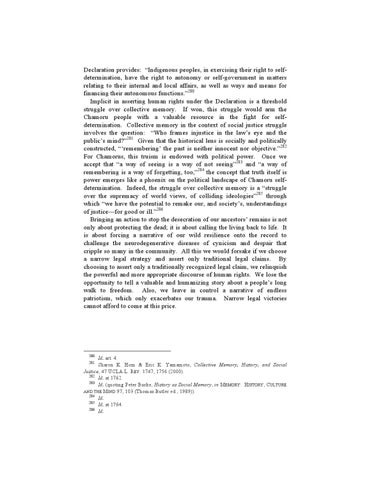Declaration provides: “Indigenous peoples, in exercising their right to selfdetermination, have the right to autonomy or self-government in matters relating to their internal and local affairs, as well as ways and means for financing their autonomous functions.”280 Implicit in asserting human rights under the Declaration is a threshold struggle over collective memory. If won, this struggle would arm the Chamoru people with a valuable resource in the fight for selfdetermination. Collective memory in the context of social justice struggle involves the question: “Who frames injustice in the law’s eye and the public’s mind?”281 Given that the historical lens is socially and politically constructed, “‘remembering’ the past is neither innocent nor objective.”282 For Chamorus, this truism is endowed with political power. Once we accept that “a way of seeing is a way of not seeing”283 and “a way of remembering is a way of forgetting, too,”284 the concept that truth itself is power emerges like a phoenix on the political landscape of Chamoru selfdetermination. Indeed, the struggle over collective memory is a “struggle over the supremacy of world views, of colliding ideologies”285 through which “we have the potential to remake our, and society’s, understandings of justice—for good or ill.”286 Bringing an action to stop the desecration of our ancestors’ remains is not only about protecting the dead; it is about calling the living back to life. It is about forcing a narrative of our wild resilience onto the record to challenge the neurodegenerative diseases of cynicism and despair that cripple so many in the community. All this we would forsake if we choose a narrow legal strategy and assert only traditional legal claims. By choosing to assert only a traditionally recognized legal claim, we relinquish the powerful and more appropriate discourse of human rights. We lose the opportunity to tell a valuable and humanizing story about a people’s long walk to freedom. Also, we leave in control a narrative of endless patriotism, which only exacerbates our trauma. Narrow legal victories cannot afford to come at this price.
280
Id. art. 4. Sharon K. Hom & Eric K. Yamamoto, Collective Memory, History, and Social Justice, 47 UCLA L. REV. 1747, 1756 (2000). 282 Id. at 1762. 283 Id. (quoting Peter Burke, History as Social Memory, in MEMORY: HISTORY, CULTURE AND THE MIND 97, 103 (Thomas Butler ed., 1989)). 284 Id. 285 Id. at 1764. 286 Id. 281
